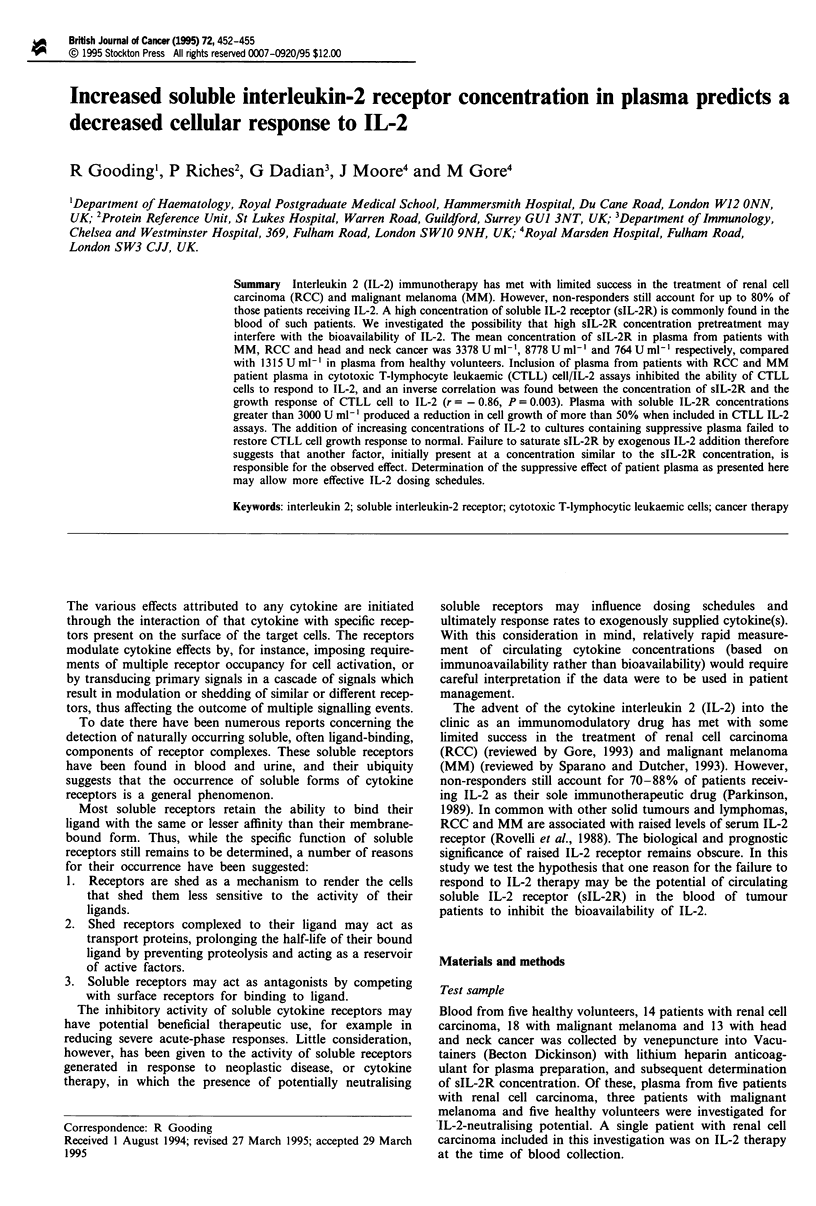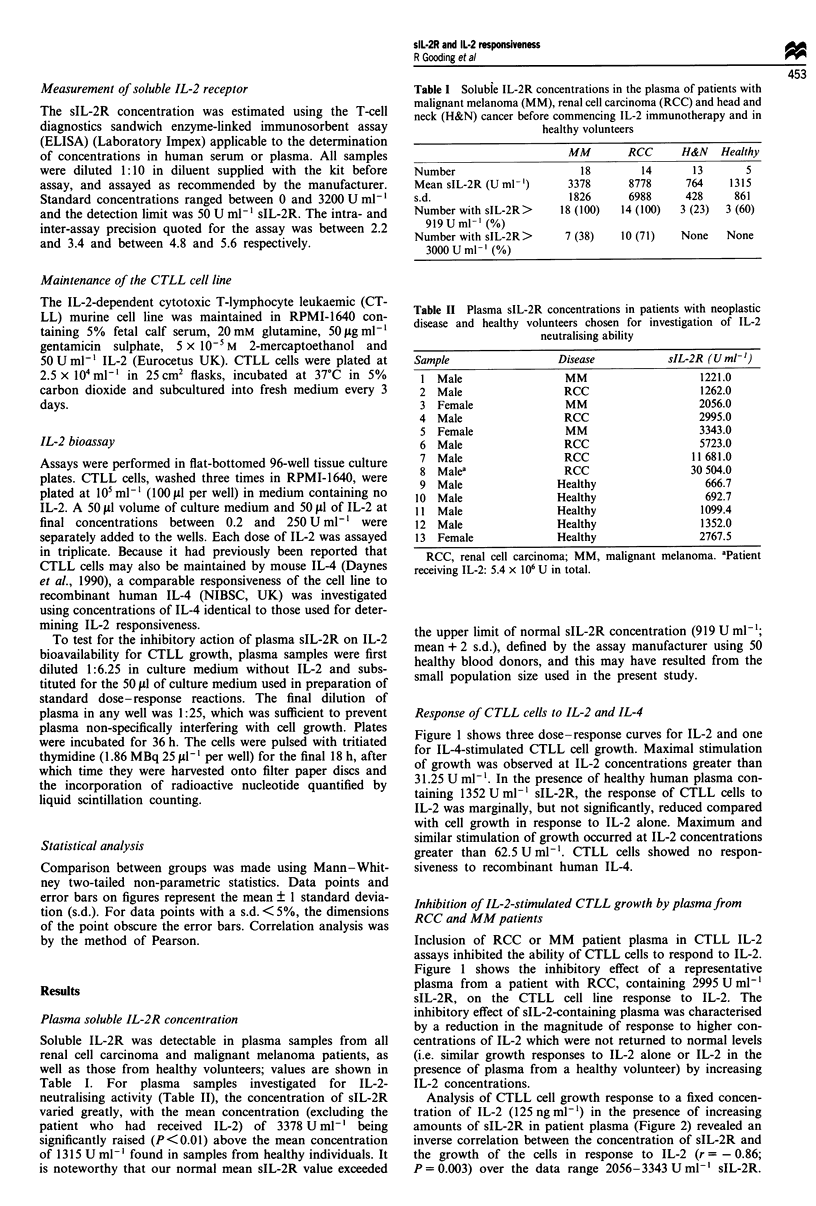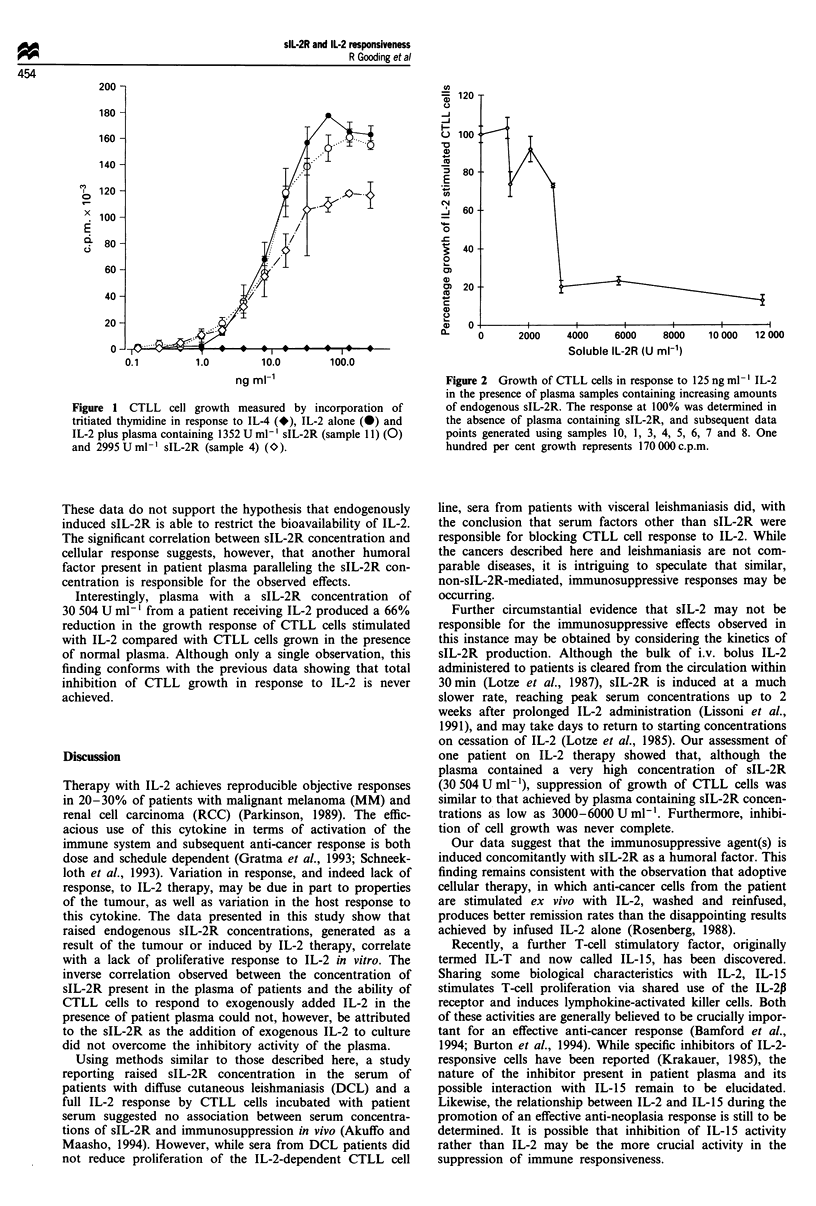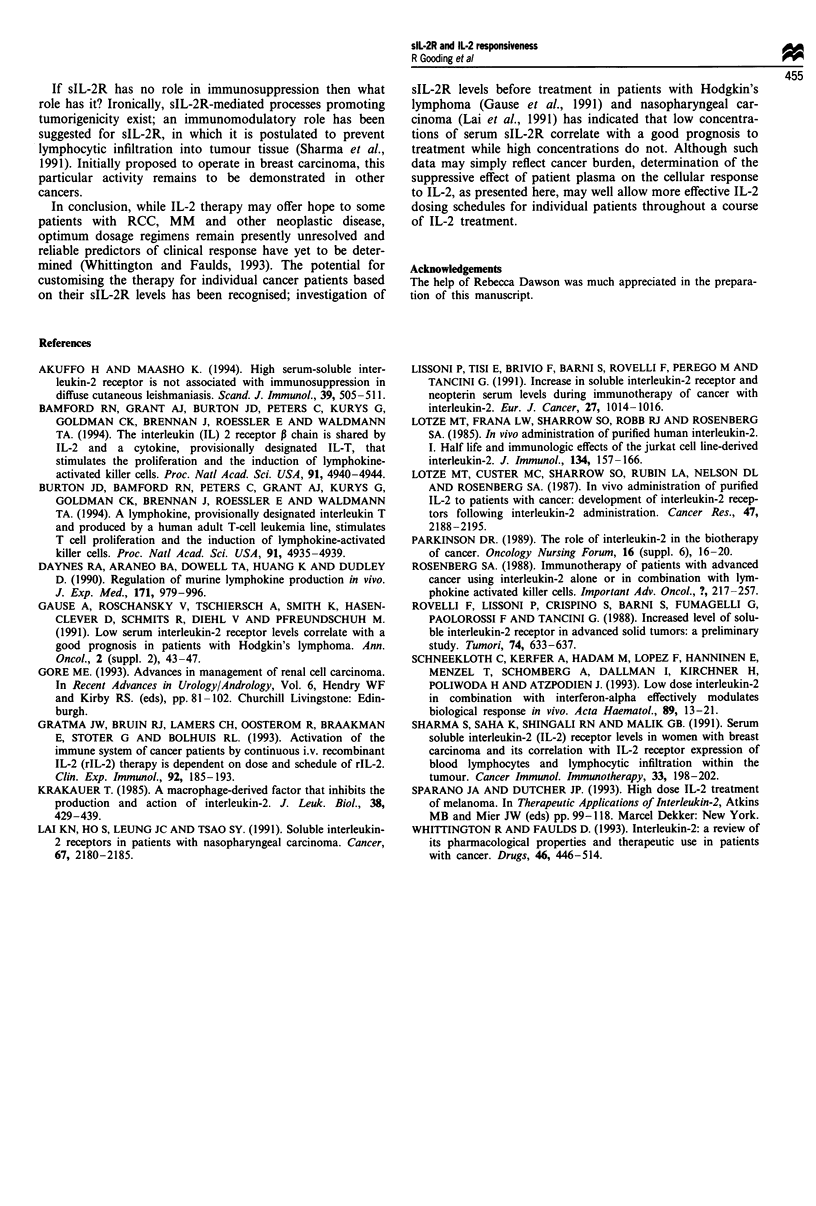Abstract
Interleukin 2 (IL-2) immunotherapy has met with limited success in the treatment of renal cell carcinoma (RCC) and malignant melanoma (MM). However, non-responders still account for up to 80% of those patients receiving IL-2. A high concentration of soluble IL-2 receptor (sIL-2R) is commonly found in the blood of such patients. We investigated the possibility that high sIL-2R concentration pretreatment may interfere with the bioavailability of IL-2. The mean concentration of sIL-2R in plasma from patients with MM, RCC and head and neck cancer was 3378 U ml-1, 8778 U ml-1 and 764 U ml-1 respectively, compared with 1315 U ml-1 in plasma from healthy volunteers. Inclusion of plasma from patients with RCC and MM patient plasma in cytotoxic T-lymphocyte leukaemic (CTLL) cell/IL-2 assays inhibited the ability of CTLL cells to respond to IL-2, and an inverse correlation was found between the concentration of sIL-2R and the growth response of CTLL cell to IL-2 (r = -0.86, P = 0.003). Plasma with soluble IL-2R concentrations greater than 3000 U ml-1 produced a reduction in cell growth of more than 50% when included in CTLL IL-2 assays. The addition of increasing concentrations of IL-2 to cultures containing suppressive plasma failed to restore CTLL cell growth response to normal. Failure to saturate sIL-2R by exogenous IL-2 addition therefore suggests that another factor, initially present at a concentration similar to the sIL-2R concentration, is responsible for the observed effect. Determination of the suppressive effect of patient plasma as presented here may allow more effective IL-2 dosing schedules.
Full text
PDF



Selected References
These references are in PubMed. This may not be the complete list of references from this article.
- Akuffo H., Maasho K. High serum-soluble interleukin-2 receptor is not associated with the immunosuppression in diffuse cutaneous leishmaniasis. Scand J Immunol. 1994 May;39(5):505–511. doi: 10.1111/j.1365-3083.1994.tb03406.x. [DOI] [PubMed] [Google Scholar]
- Bamford R. N., Grant A. J., Burton J. D., Peters C., Kurys G., Goldman C. K., Brennan J., Roessler E., Waldmann T. A. The interleukin (IL) 2 receptor beta chain is shared by IL-2 and a cytokine, provisionally designated IL-T, that stimulates T-cell proliferation and the induction of lymphokine-activated killer cells. Proc Natl Acad Sci U S A. 1994 May 24;91(11):4940–4944. doi: 10.1073/pnas.91.11.4940. [DOI] [PMC free article] [PubMed] [Google Scholar]
- Burton J. D., Bamford R. N., Peters C., Grant A. J., Kurys G., Goldman C. K., Brennan J., Roessler E., Waldmann T. A. A lymphokine, provisionally designated interleukin T and produced by a human adult T-cell leukemia line, stimulates T-cell proliferation and the induction of lymphokine-activated killer cells. Proc Natl Acad Sci U S A. 1994 May 24;91(11):4935–4939. doi: 10.1073/pnas.91.11.4935. [DOI] [PMC free article] [PubMed] [Google Scholar]
- Daynes R. A., Araneo B. A., Dowell T. A., Huang K., Dudley D. Regulation of murine lymphokine production in vivo. III. The lymphoid tissue microenvironment exerts regulatory influences over T helper cell function. J Exp Med. 1990 Apr 1;171(4):979–996. doi: 10.1084/jem.171.4.979. [DOI] [PMC free article] [PubMed] [Google Scholar]
- Gause A., Roschansky V., Tschiersch A., Smith K., Hasenclever D., Schmits R., Diehl V., Pfreundschuh M. Low serum interleukin-2 receptor levels correlate with a good prognosis in patients with Hodgkin's lymphoma. Ann Oncol. 1991 Feb;2 (Suppl 2):43–47. doi: 10.1007/978-1-4899-7305-4_7. [DOI] [PubMed] [Google Scholar]
- Gratama J. W., Bruin R. J., Lamers C. H., Oosterom R., Braakman E., Stoter G., Bolhuis R. L. Activation of the immune system of cancer patients by continuous i.v. recombinant IL-2 (rIL-2) therapy is dependent on dose and schedule of rIL-2. Clin Exp Immunol. 1993 May;92(2):185–193. doi: 10.1111/j.1365-2249.1993.tb03378.x. [DOI] [PMC free article] [PubMed] [Google Scholar]
- Krakauer T. A macrophage-derived factor that inhibits the production and action of interleukin 2. J Leukoc Biol. 1985 Sep;38(3):429–439. doi: 10.1002/jlb.38.3.429. [DOI] [PubMed] [Google Scholar]
- Lai K. N., Ho S., Leung J. C., Tsao S. Y. Soluble interleukin-2 receptors in patients with nasopharyngeal carcinoma. Cancer. 1991 Apr 15;67(8):2180–2185. doi: 10.1002/1097-0142(19910415)67:8<2180::aid-cncr2820670829>3.0.co;2-t. [DOI] [PubMed] [Google Scholar]
- Lissoni P., Tisi E., Brivio F., Barni S., Rovelli F., Perego M., Tancini G. Increase in soluble interleukin-2 receptor and neopterin serum levels during immunotherapy of cancer with interleukin-2. Eur J Cancer. 1991;27(8):1014–1016. doi: 10.1016/0277-5379(91)90271-e. [DOI] [PubMed] [Google Scholar]
- Lotze M. T., Custer M. C., Sharrow S. O., Rubin L. A., Nelson D. L., Rosenberg S. A. In vivo administration of purified human interleukin-2 to patients with cancer: development of interleukin-2 receptor positive cells and circulating soluble interleukin-2 receptors following interleukin-2 administration. Cancer Res. 1987 Apr 15;47(8):2188–2195. [PubMed] [Google Scholar]
- Lotze M. T., Frana L. W., Sharrow S. O., Robb R. J., Rosenberg S. A. In vivo administration of purified human interleukin 2. I. Half-life and immunologic effects of the Jurkat cell line-derived interleukin 2. J Immunol. 1985 Jan;134(1):157–166. [PubMed] [Google Scholar]
- Parkinson D. R. The role of interleukin-2 in the biotherapy of cancer. Oncol Nurs Forum. 1989 Nov-Dec;16(6 Suppl):16–20. [PubMed] [Google Scholar]
- Rosenberg S. A. Immunotherapy of patients with advanced cancer using interleukin-2 alone or in combination with lymphokine activated killer cells. Important Adv Oncol. 1988:217–257. [PubMed] [Google Scholar]
- Rovelli F., Lissoni P., Crispino S., Barni S., Fumagalli G., Paolorossi F., Tancini G. Increased level of soluble interleukin-2 receptor in advanced solid tumors: a preliminary study. Tumori. 1988 Dec 31;74(6):633–637. doi: 10.1177/030089168807400603. [DOI] [PubMed] [Google Scholar]
- Schneekloth C., Körfer A., Hadam M., Lopez Hänninen E., Menzel T., Schomburg A., Dallmann I., Kirchner H., Poliwoda H., Atzpodien J. Low-dose interleukin-2 in combination with interferon-alpha effectively modulates biological response in vivo. Acta Haematol. 1993;89(1):13–21. doi: 10.1159/000204476. [DOI] [PubMed] [Google Scholar]
- Sharma S., Saha K., Shinghal R. N., Malik G. B. Serum soluble interleukin-2 (IL-2) receptor levels in women with breast carcinoma and its correlation with IL-2 receptor expression on blood lymphocytes and lymphocytic infiltration within the tumour. Cancer Immunol Immunother. 1991;33(3):198–202. doi: 10.1007/BF01756142. [DOI] [PMC free article] [PubMed] [Google Scholar]
- Whittington R., Faulds D. Interleukin-2. A review of its pharmacological properties and therapeutic use in patients with cancer. Drugs. 1993 Sep;46(3):446–514. doi: 10.2165/00003495-199346030-00009. [DOI] [PubMed] [Google Scholar]


